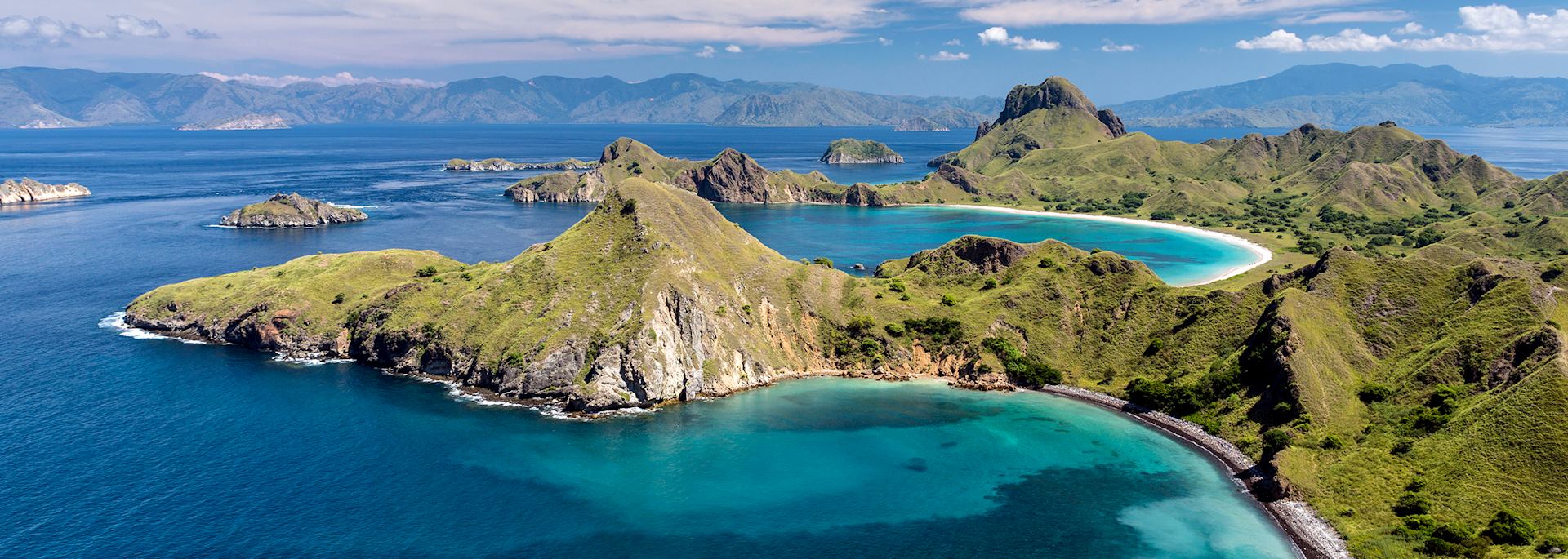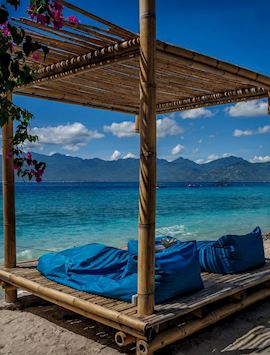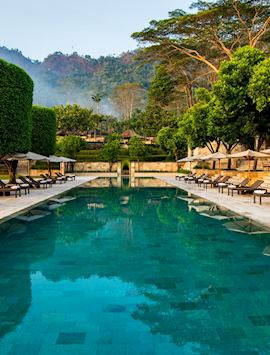By Indonesia specialist Faye
Indonesia's beaches, particularly on Lombok, are the best I've encountered. But, the versatility of this archipelago of 18,000 islands, which measures as wide as the USA, ranges far beyond a honeymoon beach destination.
If you've time to take two or three weeks for your honeymoon, I'd encourage you to cast your net wider.
Island hop from the orangutan-inhabited rainforests of Indonesian Borneo to the quieter, undeveloped side of Bali. On Java, Borobudur shows off the temple-building prowess of the Indonesians, a clear landmark from the peaceful Menoreh Hills, one of the most relaxing places I've stayed.
And, at some point on your honeymoon, take to the water, cruising the rarely seen Raja Ampat islands or Komodo National Park in search of the dragons.
Riverboat cruise to spot orangutans

In Tanjung Puting National Park on Indonesian Borneo, the river curls its way through thickset, intensely green rainforest. This isn't, perhaps, a honeymoon setting that automatically springs to mind, but one I'd recommend for anyone with a keen sense of adventure.
As you follow the river's course by klotok — a traditional boat, and your hotel for the night — the vibrancy of the jungle is all around. Look to your right and a bright kingfisher zips past, to your left and an orangutan stands just a few footsteps away.
With zero artificial light, the canopy of stars intensifies as the night deepens and fireflies congregate in trees like strings of fairy lights. Sleep under the stars on the open deck of your riverboat, or below deck in an air-conditioned cabin.
Waking in the morning to the sound of the gibbons calling and a dawn chorus from over 230 bird species, you're likely to see orangutans a few metres away on the river edge and in their tree nests along the bank.
Feeding stations give the reliable opportunity of watching large groups of 20 or 30 orangutans at a time. The burly alpha males and mothers swinging down with their babies gripping their chests.
Explore Bali’s untouched east

Bali is often thought of for honeymoons, and its eastern side is the less obvious but more romantic choice.
In the villages here, away from the busier and more developed south of the island, farmers still drag their tools to plough and work the land using buffalo, much as they did 500 years ago.
Under the thatched roofs of the village houses, women sit at looms producing traditional ikat textiles in brightly coloured geometric patterns. Workers on the rice terraces that ripple down the hillsides collect the rice in their woven baskets, overlooked by the jungle and Mount Barat, one of Bali's most spiritual sites.
The best way to discover eastern Bali's local villages, such as those in the area of Sidemen, is to tour around with a private guide or by bicycle. Most of the hotels in the area have a store of bicycles, including the beachside Alila Manggis, my recommended place to stay.
Cooking with a local family in Bali

Ubud is Bali's cultural heart, and its restaurants are fast building a reputation for good food, inspired by dishes that originated on the cooking stoves of family homes.
In Ubud, you can meet a local family and help with the preparation of a meal as an authentic introduction to Indonesian cooking.
Recipes are likely to centre round curries and satays of chicken and fish. Chunks of jackfruit are thrown in for sweetness. As the meal develops, your hosts explain how rice is cultivated on Bali, before you sit down to eat and talk.
Glamping by the river

Ubud has plenty of traditional Balinese hotels, but I'd recommend a stay at Sandat Glamping Tents. Set by a pool in a river valley, a 15-minute drive from Ubud, this first glamp-site to appear in Bali feels like a true getaway, but with the town still within easy reach.
Sandat is tucked away in a corner of a rice field, and days based here are spent on walks through the valley or rafting in the river.
Lombok’s undeveloped beaches

A 30 km boat trip separates Lombok from its next-door neighbour Bali, and after touring Bali for its culture I'd take the short hop to Lombok for its beaches.
More than happy to let Bali bask in its popularity, Lombok holds on to its peaceful, get-away-from-it feel, but it has the more beautiful and less built-up beaches and the more characterful places to stay.
Quirky boutique hotels are tucked away on the edge of horseshoe bays of powdery white sand, running down into turquoise waters that are great for snorkelling and diving. My standout favourite is the Tugu Lombok, a gorgeous, intimate resort with just 19 beautifully designed rooms.
Beach camp on a deserted cove in Lombok

Lombok is low key to start with, but Jeeva Beloam Beach Camp in the south of the island is off the grid. The name conjures images of tents on the sand, but it's rather more well-established than that.
A solitary row of five steep-gabled thatched buildings stands on a deserted cove in the middle of nowhere, secluded by the cliff face.
Lombok's other hotels have more facilities — pools and spas — and are closer to civilisation, but you can come here for a few nights and get away from it all completely. Other than relaxing, the only activities are cycling, fishing and snorkelling, or thumbing a book in the reading room.
The camp feels fully escapist, but a small team are always on hand, including the chef who will serve any fish you catch.
Island cruising in Komodo National Park

The water that flows around Indonesia's islands attributes for a third of its territory and a honeymoon would feel incomplete without spending some time on the water.
The Komodo National Park is a set of islands best explored from a liveaboard boat. The journey starts by flying from Bali to Flores, a few islands to the east. At Labuan Bajo Harbour you meet your vessel, crew and guide and set sail for two nights to explore the national park.
The first stop is Komodo, the main island, where dragons wander freely. The males especially are pretty formidable, growing up to three metres in length from head to tail. They're also surprisingly fast for their size. Rangers escort all visitors around the park, tracking the dragons and, once found, keeping both parties at a respectful distance.
Most visitors take day trips out to the Komodo National Park, so it's nice to be in-situ, moored for the night next to one of the islands. And, in the still morning while you have the transparent waters to yourselves, you can jump off the boat side to snorkel above parrot fish, reef sharks and turtles.
Remote island cruising around the Raja Ampat Islands

It requires a series of flights and an appetite for adventure to reach Raja Ampat, a rarely visited island chain scattered off the coast of Indonesian Papua. Schooners, luxury yachts and live-a-boards ply these waters, mooring in remote waters.
Some 1,500 limestone karsts protrude from the sea, ringed with white sand and topped with jungle of the most vivid green that I've ever seen. The glassy turquoise shallows drop off into deep blue waters that are thought to support the most biodiverse marine life on Earth (new species are still being discovered). The diving here is superb.
With enough time, you could build in a seven-night cruise around the Spice Islands — once the sole supplier of nutmeg to the world.
Each boat has a crew, expert guide and a chef. Depending on the level of boat, the chef will have either grown up locally or sport international credentials. But the food served is invariably of the highest standard and likely to revolve around fish caught off the side.
Getaway stay in the hills of Central Java

Central Java is less visited than Bali but it's equally cultural. The world's largest Buddhist temple, Borobudur, has stood here since the 9th century — a confection in volcanic stone decorated with 504 Buddha statues.
You should definitely make time to see Borobudur (at sunrise, for the best experience). But there's also a simple pleasure to be had from staying in the Menoreh Hills, 40 minutes from Java's main city of Yogyakarta. Two luxurious hotel options are the Amanjiwo and the Plataran.
Looking out over the green landscape, Borobudur is often visible in the distance, as is the active volcano Mount Rapi. At certain points in the day its crater glows orange and smoke drifts out.
Spending a few days of your honeymoon in the Menoreh Hills is mainly about doing very little, but you can bicycle through the local villages to the foothills of Mount Rapi at a very leisurely pace. I stopped to ponder the great globules of solidified lava from past eruptions and the ruins of one village, which had been consumed by the lava flow.
The best time to honeymoon in Indonesia
The whole of the Indonesian island chain enjoys its best weather from March to October.
Scattered close to the Equator, the islands enjoy day-time 30-degree temperatures and fine weather all year round.
Start planning your honeymoon to Indonesia
Start thinking about your experience. These itineraries are simply suggestions for how you could enjoy some of the same experiences as our specialists. They're just for inspiration, because your trip will be created around your particular tastes.
View All Tours in Indonesia




